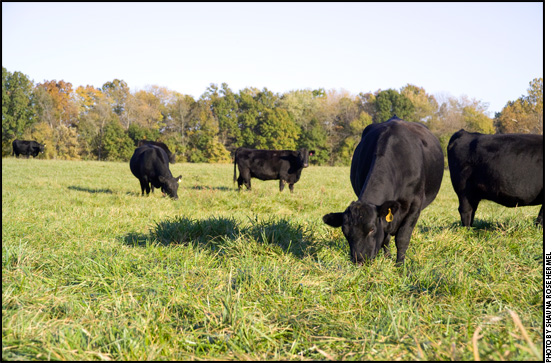HEALTH & NUTRITION...
Make the Most of Your Mineral Program
Could you be cutting costs on your mineral program — without impacting animal performance? It's worth re-evaluating, suggests Ainsworth, Neb.-based Extension educator Dennis Bauer. "If you are spending over $15-$20 per head per year on mineral, you might want to get a second opinion." He says mineral cost on a per-cow basis per year can be as low as $5 per head.
Bauer notes that many forages have adequate mineral levels. By knowing your feedstuffs, you can better develop a mineral mix that is cost-effective for your needs. Bauer and several Nebraska Extension educator colleagues analyzed more than 1,000 feedstuff samples from 11 northeast Nebraska counties. From those findings, he offers four tips. Read more.
Is Perception of Inactivated Vaccines Outdated?
Scientific journal report shows old misconceptions don't apply to modern products.
A recent study published in the scientific journal Veterinary Therapeutics provides new evidence that a long-standing perception about inactivated vaccines has become outdated and inaccurate. The study showed that Vira Shield® 6 — an inactivated vaccine — produced complete and long-lasting immunity against bovine viral diarrhea (BVD) virus by stimulating both branches of the bovine immune system.1
Results of the study challenge a long-held belief among many cattle industry professionals that was founded long before some of the current inactivated vaccines were even on the market. Read more.
Trichomoniasis in Cattle:
Could it be coming to a herd near you?
For herds experiencing low pregnancy rates, a venereal disease called trichomoniasis, or trich, may be a likely culprit, University of Missouri (MU) Extension Veterinarian Craig Payne told Missouri cattle producers at a Sept. 16 beef field day at MU South Farm, Columbia.
Trich is caused by a protozoan parasite called Tritrichomonas foetus. Transmission of this organism during breeding can reduce the calf crop by as much as 50% due to early embryonic death or abortion, Payne said. "This disease can have a devastating financial impact because of poor calf crops and expenses associated with cleaning up an infected herd." Read more.
Revisions to Texas Cattle
Trichomoniasis Regulations Adopted
Changes to Texas' cattle trichomoniasis, or "trich," regulations were adopted Oct. 5 by the 13 governor-appointed leaders of the Texas Animal Health Commission (TAHC) and will become effective in November 2010. Andy Schwartz, TAHC assistant state veterinarian and epidemiologist, discussed the program and outlined rule changes for board members of the Independent Cattlemen's Association of Texas (ICA). Read more.

Rick Rasby
Ridin’ Herd
How cow weight, milk output affect feed costs
Last month we discussed the effect of mature weight and milk production on dollars generated in a cow-calf enterprise. The females differed in mature weight, but had the same milk output. When accounting for a price slide and some discounts, cows with a mature weight of 1,200 pounds (lb.) generated the most revenue, followed by the 1,000-lb. mature females, then the 1,400-lb. mature females. Because feed costs are between 40% and 60% of annual cow costs, what are the forage feed cost differences between the herds that have cows of different mature weights but the same milk output? Read more.
Minnesota's TB Status Upgrade Effective Immediately
Effective Oct. 1, the majority of Minnesota has been upgraded to bovine Tuberculosis (TB) Accredited-Free, and a small area in northwest Minnesota changed to Modified Accredited Advanced (MAA). The State of Minnesota has been working with producers since 2005 to eliminate the disease from northwestern Minnesota and regain the state's TB-Free status.
Producers raising cattle in the Management Zone will continue the same testing, movement and fencing requirements. However, this upgrade brings reductions in testing and movement requirements for the rest of the new MAA Zone.
For farmers in this area who raise cattle or bison, as of Oct. 1, no TB test will be required for feeder cattle leaving the herd [official identification (ID) still required] and an Animal Movement Certificate is not required for within-herd movement.
Those herds located in the TB-Free area have no federal TB testing requirements; however, some states may have import requirements. Producers should continue to verify import requirements with the receiving state prior to shipping animals out of state.
"The upgrades signify the achievement of one more step in our continuing effort to eradicate TB from Minnesota," said State Veterinarian and Minnesota Board of Animal Health Executive Director Bill Hartmann. "The Board of Animal Health, the Minnesota Department of Agriculture, and Minnesota Department of Natural Resources remain committed to continuing eradication efforts until the entire state of Minnesota regains its TB-Free Status and TB is not found in free-ranging deer for five consecutive years."
More information can be obtained by logging on to the State's bovine TB website at www.mntbfree.com or by calling the bovine TB Hotline at 1-877-668-2373.
A New Look at Pinkeye
Pinkeye continues to frustrate cattle producers despite advances in knowledge and vaccine technology, notes University of Missouri (MU) Extension Veterinarian Craig Payne. "Dealing with pinkeye is frustrating at best." While there's no magic bullet that will guard herds from pinkeye, understanding the complex causes of pinkeye can help producers make smarter decisions about managing outbreaks in their herds. Read more.
Keep it Simple
Choosing a respiratory vaccine program can be as easy as answering five simple questions.
Getting the most out of a respiratory vaccine comes down to a few simple questions producers should ask themselves, says Veterinarian Gerald Stokka, Veterinary Operations, Pfizer Animal Health. Answering these questions can help ensure a herd health program has a strong foundation for the entire year. Read more.
Cattle Diseases: Common Conditions/Terms
Click here for a list of common conditions and terms related to beef cattle diseases, such as anaplasmosis, brucellosis, BVD, E. coli, IBR and others.
[Click here to go to the top of the page.]






